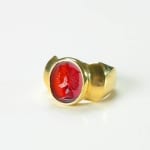Intaglio Depicting a Female Deity or Roman Empress, 1700 CE - 1800 CE
Carnelian-Gold
FJ.6480
Further images
The art of glyptics, or carving on colored precious stones, is probably one of the oldest known to humanity. Intaglios, gems with an incised design, were made as early as...
The art of glyptics, or carving on colored precious stones, is probably one of the oldest known to humanity. Intaglios, gems with an incised design, were made as early as the fourth and third millennia BC in Mesopotamia and Aegean Islands. They display a virtuosity of execution that suggests an old and stable tradition rooted in the earliest centuries. The tools required for carving gems were simple: a wheel with a belt-drive and a set of drills. Abrasives were necessary since the minerals used were too hard for a metal edge. A special difficulty of engraving intaglios, aside from their miniature size, was that the master had to work with a mirror image in mind. To the ancient Greeks and Romans there was a close connection between an immortal deity and a mortal empress. After their deaths many empresses were deified, often at the bequest of their emperor husbands who wished to immortalize their memory. On this lovely intaglio great care was given to the fashioning of the coiffure, with its delicate curls around the forehead, and those rippling down the back. She also wears a laurel wreath, which was more an attribute of male rulers and divine goddesses. Her profile is very noble and proud, facing left with an expression that is regal, but with a faint hint of a smile. Whoever she may be, goddess or queen, she is certainly a proud symbol of strength, elegance and beauty.





